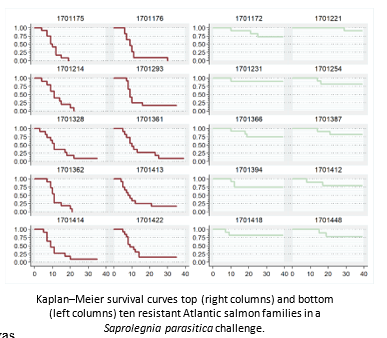FISH TO FISH VARIABILITY IN RESISTANCE TO Saprolegnia parasitica INFECTION IN ATLANTIC SALMON Salmo salar
Infections by the Oomycete Saprolegnia sp. are problematic to freshwater salmon hatcheries worldwide. Banning use of malachite green oxalate, which was an effective treatment of choice but has carcinogenic and teratogenic properties on humans, with more recent actions to ban formalin use creates a new challenge to control Saprolegnia in affected hatcheries. The search to identify new bath treatment options also begs the question as to whether selective breeding might be useful in decreasing susceptibility and mitigate impact on salmon hatcheries. The overall purpose of this research was to phenotypically characterize the variability in resistance/susceptibility amongst families of one year class of Atlantic salmon.
In this study, a controlled Saprolegnia parasitica infection model was used to challenge 1158 fish representing 105 pedigreed Atlantic salmon families. Fish were infected in five study tanks and observed for 40 days post-infection to assess a novel lesion score and survival.
Survival analysis of the top and bottom ten resistant families indicated that the hazard of dying following Saprolegnia infection was 1509% higher in susceptible families. In all fish, a 10 g increase in weight correlated with a 7.8% increase in the hazard of dying while sex did not affect mortality.
Resistance to Saprolegnia infection was estimated to have a heritability of 0.25±0.06 or higher, indicating that selection is possible. The genetic or phenotypic correlations between resistance traits to weight was ≤0.29±0.14 indicating both freshwater growth and Saprolegnia resistance could be selected for simultaneously.
In addition, a novel 11-point fungal lesion scoring method was developed for use on all mortalities and survivors. This scoring method had genetic or phenotypic correlations of ≥-0.87±0.01 with both survival and mortality indicating that the scoring method may be helpful to assess lesion development in studies where mortality is not the primary biological endpoint.
